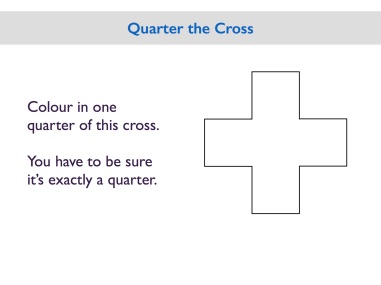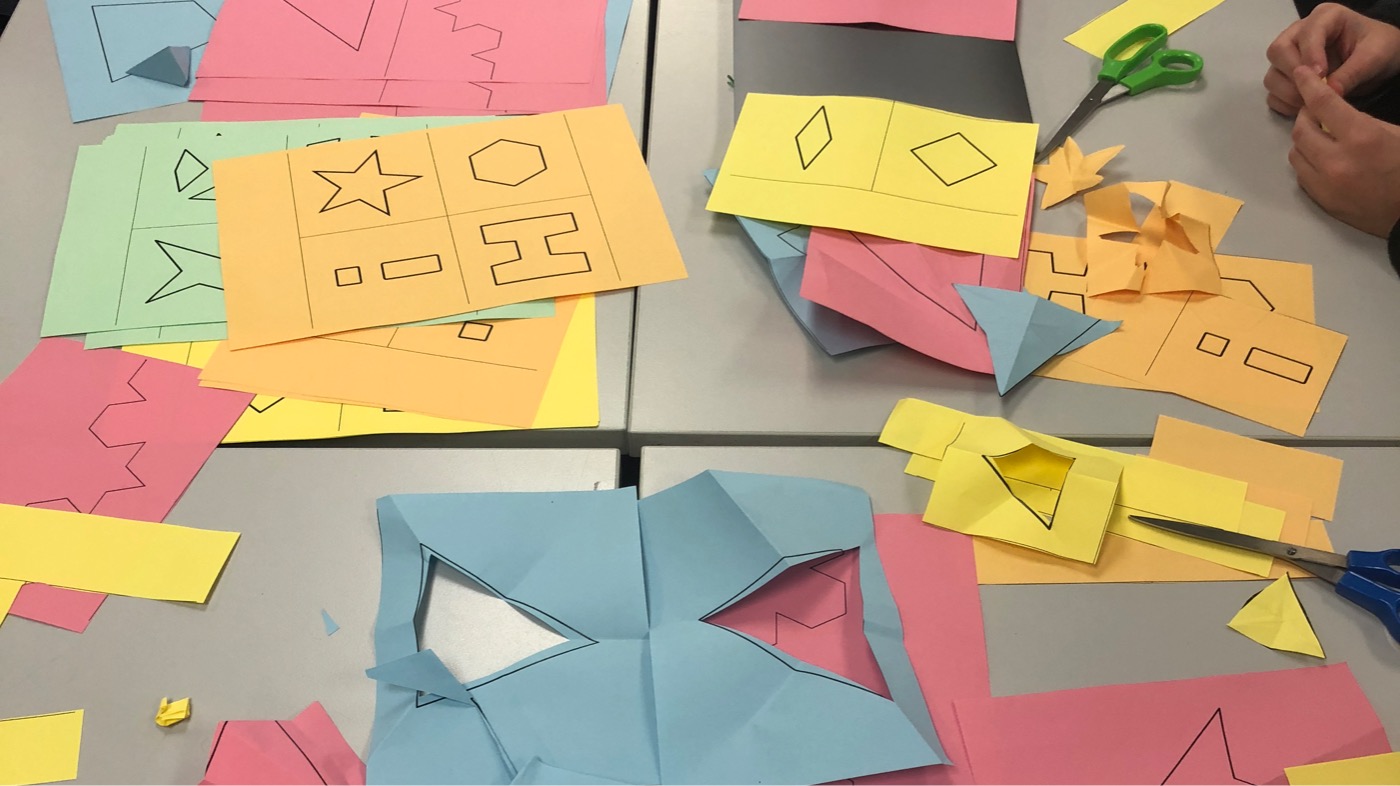This is the second in a planned series of posts about my course ‘Developing Mathematical Thinking’, a maths content elective for pre-service teachers training in primary and middle maths. All posts in the series are here.
Last week I wrote about my three main goals for my Developing Mathematical Thinking course. You can read that post here. Today I want to talk about the activities I used in the first workshop: why I chose them, how they unfolded, and the discussion that resulted.
The two activities are Fold-and-Cut and Quarter the Cross. Along with ~35 minutes of other discussion, these activities took the entire 1hr 45 min workshop and another 30 minutes of the next. Regular readers will think by now that I’m somewhat obsessed with both of these activities (it is true; I’ve already written about them here and here), but they are such rich tasks. In this post I add more detail, particularly from the perspective of using them in the (pre-service teacher) classroom.
1. Fold-and-cut
Duration: ~50 minutes
I wanted the very first activity to: be non-threatening and hands-on, encourage students (who may not have met) to talk with one another, not look like a typical maths task, accommodate a variety of problem-solving strategies, and allow me to gently start eliciting explanations of their thinking. Sounds like fold-and-cut is ideal!
As before, I started by showing the first 2:30 min of Katie Steckles’ Numberphile video on the fold-and-cut theorem. (As a reminder, the task is to fold the shape so that it can be removed from the paper with one straight cut.) I gave out the first three pages of this revised handout with the yellow, green and blue shapes in the photos above. (Credits for the handouts due to JD Hamkins and Patrick Honner; see my earlier fold-and-cut post.)
After everyone had tackled most of the shapes, we stopped to reflect. I made reference back to the four lenses with which they could view each task (maths learner, maths thinker, student, teacher), and asked them to brainstorm possible maths content in the task, maths thinking they used, thoughts that I may have had as a teacher in presenting/selecting the task, any other ideas. An incomplete list is below:
- Maths content. Shapes terminology (for example, regular and irregular polygons, convex and concave polygons, equilateral, equiangular), symmetry properties, angles, angle bisectors, triangle incenter, optimisation/efficiency (minimum number of cuts). Later we added fractals and Koch curve.
- Maths thinking. Trial-and-error, guess-and-check, noticing (what we did, what others did) and wondering (for example, can I do it with fewer folds?), making a problem smaller, reducing to a problem we already know how to solve, reflecting on what went wrong/right, transferring skills to a new problem.
- Teacher lens. We thought that the task: gives students choice about where to start and how to do it; has an ‘easy’ entry; builds confidence; is ‘open’; is engaging, visual and hands-on; allows multiple approaches; is low risk and low threshold, high ceiling.
I shared that this was the first time that I had handed out all three pages without suggesting that students start on the yellow (easiest) page. We reflected about whether some people started with one that looked easiest (to give them confidence), the one that looked hardest (because they wanted a challenge), or some other shape for some other reason.
I then gave them the last two pages (pink and orange in the photo) with irregular shapes and the Koch curve. Discussion points included: we couldn’t necessarily rely on properties of symmetry anymore; they felt they could do these ones now that they’d build confidence on the first three pages; the Koch curve looked hard but turned out to be easier than expected (an experience that might hold them in good stead in the future!). I also directed them towards Chapter 3 of the free book ‘Art & Sculpture’ from Discovering the Art of Mathematics, which has a well thought-out sequence of prompts that might make a suitable classroom investigation.
In all, I was really pleased how this activity unfolded, and how we were immediately able to use the ‘four lenses’ idea as a framework for reflection.
2. Quarter the Cross
Duration: ~45 minutes (spread over two classes)
I am very thankful to David Butler for sharing here about the mathematical ideas he sees in this activity, and here about using this activity in his daughter’s Year 7 classroom; this was excellent guidance.
My reasons for using this task were: promote creativity, encourage students to find different ways of achieving the same goal, prompt students to give reasons for their work, lead into multiple representations.
 I started by showing the slide. I then handed out six smaller copies of the cross. I encouraged students to use whatever method they wanted; some chose to cut them out (most likely because we had just been doing fold-and-cut), others used rulers, some drew free-hand.
I started by showing the slide. I then handed out six smaller copies of the cross. I encouraged students to use whatever method they wanted; some chose to cut them out (most likely because we had just been doing fold-and-cut), others used rulers, some drew free-hand.
After students had coloured in six, I picked two of the shapes that most people find in their first few: the ‘house’ and the ‘L’. (See below.)
- We started with the ‘house’. Some students shared that they found it using symmetry; others shared that they saw it as one full square plus a quarter of another one.
- We moved onto the ‘L’. Along with symmetry, another approach was to decompose the whole cross into a smaller number of equal parts. A key observation was that making the number of equal parts divisible by 4 made it easier to shade a quarter. (The orange cross on the bottom right is another example of this.)
- We then discussed the one with five blue triangles, and noted that it could be made from the house by moving bits around (which doesn’t change the area). (The red triangle-type shape in the bottom row is also like this).
- Finally we talked about how adding a bit and taking the same bit doesn’t change the area, which is how the green one with circles came about.

I also used different examples of student work to illustrate these strategies.
I then showed them David’s one hundred solutions (see his blog post). I zoomed in on some of the more complicated-looking ones as examples of the mathematical scope of the activity. Their homework task was to colour in another six based on their ideas from our discussion, and from examining their classmates’ work.
Multiple representations
In the next workshop, I started by noting that we had two ways of considering the cross: as one whole, or as composed of five smaller squares. I asked them to concentrate on the second method. If one square is a unit, then what does it mean to ‘quarter the cross’? We need to shade 1/4 of 5 units, so 5/4 units.
Now we started exploring different ways of expressing 5/4, and connecting them to corresponding visual representations. Once again, we used student work to illustrate these. For example:
- 5/4 = 5×(1/4). Colour in 1/4 of one unit. Do this five times. (We can move those bits around later if we want.)
- 5/4 = 1 + 1/4. Colour in one whole unit and a quarter of another. (An example is the house.)
- 5/4 = 2×(5/8). Colour in 5/8 of one unit. Do this two times.
- 5/4 = (1/2)×(5/2). This one was interesting, as it was the first one with an improper fraction. Start with shading 2.5 units, and then colour in 1/2 of the shaded area.
- 5/4 = 1/2 + 3/4. Colour in 1/2 of one unit and 3/4 of another unit.
We reflected on how much richer this task had become with the introduction of another representation, and how being able to translate between the two representations promoted deeper understanding about fractions. This was a great lead-in to the rest of Workshop 2; I’ll write about this soon.



Really like how you went to the fraction representation for Quarter the Cross. We didn’t get that far in my daughter’s year 7 class, but I would totally have gone there on a different day. I actually think having some space between us a great idea, to bask in the glory of the other solutions before trying something new.
LikeLike